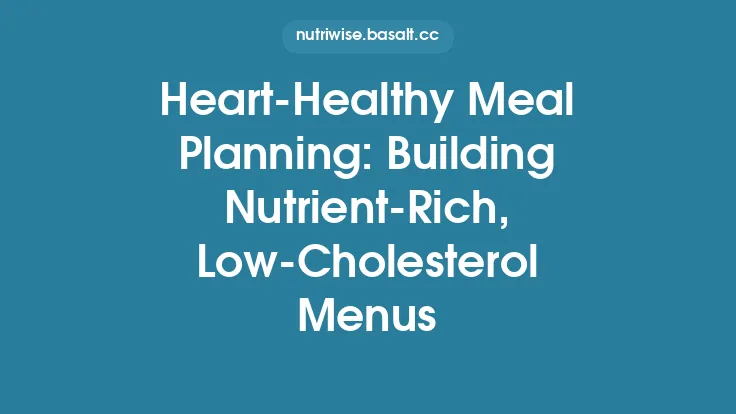Seasonal produce offers a natural, flavorful, and nutrient‑dense way to support cardiovascular health throughout the year. By aligning your grocery list with what’s at its peak in each season, you not only enjoy superior taste and texture but also maximize the intake of heart‑protective compounds such as potassium, dietary fiber, polyphenols, and essential vitamins. This article explores the science behind these nutrients, highlights the best produce choices for each season, and provides practical tips for selecting, storing, and incorporating them into a heart‑healthy diet.
Why Seasonal Produce Matters for Heart Health
Nutrient density at its peak
Plants synthesize phytochemicals in response to environmental stressors—sunlight, temperature fluctuations, and pest pressure. When harvested at the height of their natural growth cycle, fruits and vegetables contain higher concentrations of antioxidants (e.g., flavonoids, carotenoids), vitamins (C, K, folate), and minerals (potassium, magnesium). These compounds play direct roles in cardiovascular function:
- Potassium helps regulate blood pressure by counteracting sodium’s effect on vascular tone.
- Dietary fiber (soluble and insoluble) improves lipid profiles, reduces LDL cholesterol, and promotes satiety, aiding weight management.
- Polyphenols and carotenoids (e.g., lycopene, lutein) reduce oxidative stress and inflammation, both key drivers of atherosclerosis.
- Folate supports homocysteine metabolism; elevated homocysteine is a known risk factor for heart disease.
Reduced environmental impact
Seasonal produce typically travels shorter distances, preserving freshness and reducing the carbon footprint associated with long‑haul transportation. This aligns with broader public‑health goals of sustainable food systems.
Economic advantage
When a crop is in season, supply outpaces demand, leading to lower prices. This makes it easier to incorporate a variety of heart‑healthy foods without inflating grocery bills.
Spring: Fresh Starts with Potassium‑Rich Greens and Cruciferous Vegetables
Key produce
| Vegetable/Fruit | Heart‑healthy nutrients | Typical peak months |
|---|---|---|
| Asparagus | Folate, vitamin K, fiber | March–June |
| Spinach | Potassium, magnesium, lutein | March–May |
| Swiss chard | Magnesium, potassium, vitamin C | April–June |
| Peas (sugar & snap) | Soluble fiber, vitamin C | April–June |
| Strawberries | Anthocyanins, vitamin C, fiber | April–June |
| Rhubarb | Fiber, calcium, antioxidants | April–June |
Nutrient focus
Spring greens such as spinach and Swiss chard are especially high in magnesium, a mineral that supports normal heart rhythm and vascular tone. The folate content in asparagus aids in homocysteine regulation, while strawberries provide anthocyanins that have been linked to reduced arterial stiffness.
Selection & storage tips
- Look for deep‑green, crisp leaves without yellowing or wilting.
- Store leafy greens in a perforated bag with a damp paper towel in the refrigerator’s crisper drawer; use within 3–5 days.
- Strawberries should be firm, bright red, and free of mold; keep them dry and consume within 2 days for optimal antioxidant levels.
Summer: Vibrant Antioxidants from Tomatoes, Berries, and Stone Fruits
Key produce
| Vegetable/Fruit | Heart‑healthy nutrients | Typical peak months |
|---|---|---|
| Tomatoes | Lycopene, potassium, vitamin C | June–September |
| Watermelon | Citrulline, lycopene, potassium | June–August |
| Blueberries | Anthocyanins, fiber, vitamin K | June–August |
| Peaches | Vitamin A, potassium, fiber | July–September |
| Bell peppers (red, orange) | Vitamin C, beta‑carotene, potassium | June–September |
| Corn (fresh) | Fiber, B‑vitamins, magnesium | July–September |
Nutrient focus
Lycopene, the red pigment in tomatoes and watermelon, has been extensively studied for its ability to lower LDL oxidation—a critical step in plaque formation. Blueberries’ anthocyanins improve endothelial function, while the amino acid citrulline in watermelon may enhance nitric oxide production, supporting vasodilation.
Selection & storage tips
- Choose tomatoes that are firm yet yield slightly under gentle pressure; avoid cracks or soft spots.
- For berries, select plump, uniformly colored fruit; store in a single layer on a paper towel in the fridge to prevent crushing.
- Peaches should have a gentle fragrance and a slight give when pressed near the stem; ripen at room temperature, then refrigerate to extend shelf life.
Autumn: Fiber‑Rich Roots, Squash, and Apples for Cholesterol Management
Key produce
| Vegetable/Fruit | Heart‑healthy nutrients | Typical peak months |
|---|---|---|
| Sweet potatoes | Beta‑carotene, fiber, potassium | September–November |
| Butternut squash | Vitamin A, magnesium, fiber | September–December |
| Apples (especially with skin) | Soluble fiber (pectin), polyphenols | September–November |
| Pears | Fiber, vitamin C, copper | September–November |
| Brussels sprouts | Vitamin K, folate, glucosinolates | September–November |
| Pomegranate | Polyphenols, potassium, vitamin C | September–December |
Nutrient focus
Soluble fiber, abundant in apples and pears, binds bile acids in the intestine, prompting the liver to use circulating cholesterol to produce more bile—thereby lowering LDL levels. The glucosinolates in Brussels sprouts have anti‑inflammatory properties that may protect arterial walls.
Selection & storage tips
- Sweet potatoes should be firm, with smooth skin free of sprouts or soft spots. Store in a cool, dark place (55–60°F) for up to a month.
- Apples and pears keep best in the refrigerator’s crisper drawer; separate from strong‑smelling produce to avoid flavor transfer.
- Brussels sprouts are freshest when compact and bright green; keep them in a perforated bag and use within 5–7 days.
Winter: Vitamin‑C Powerhouses and Leafy Greens for Blood Pressure Control
Key produce
| Vegetable/Fruit | Heart‑healthy nutrients | Typical peak months |
|---|---|---|
| Kale | Vitamin K, calcium, potassium | December–February |
| Collard greens | Magnesium, fiber, vitamin C | December–February |
| Citrus fruits (oranges, grapefruits) | Vitamin C, flavanones, potassium | December–February |
| Pomegranate (still available) | Polyphenols, potassium | December–February |
| Carrots | Beta‑carotene, fiber, potassium | December–February |
| Beets | Nitrates, folate, fiber | December–February |
Nutrient focus
Vitamin C enhances endothelial function and reduces oxidative stress, while the high potassium content in kale and collard greens helps maintain optimal blood pressure. Dietary nitrates from beets are converted to nitric oxide, a vasodilator that improves arterial flexibility.
Selection & storage tips
- Kale and collard greens should have deep, unblemished leaves; store in a sealed container with a damp paper towel to retain moisture.
- Citrus fruits are best when heavy for their size and have a firm, glossy skin; they can be stored at room temperature for a week or refrigerated for longer freshness.
- Beets should be firm, with smooth skin; trim the greens (if attached) and store the roots in the refrigerator’s crisper drawer.
Practical Strategies for Integrating Seasonal Produce into a Heart‑Healthy Diet
- Plan around the farmer’s market calendar
Identify the days your local market operates and note the seasonal highlights. Building a weekly menu that mirrors market offerings ensures you’re using the freshest, most nutrient‑dense options.
- Batch‑cook and freeze for off‑season use
Many vegetables (e.g., tomatoes, berries, peas) retain their antioxidant capacity when blanched and frozen quickly. Portion them into freezer‑safe bags for smoothies, soups, or stir‑fries during months when fresh supply wanes.
- Combine complementary produce for synergistic effects
Pair vitamin‑C‑rich foods (citrus, bell peppers) with iron‑rich leafy greens (kale, spinach) to enhance non‑heme iron absorption, supporting overall cardiovascular health.
- Emphasize whole‑food forms
While juices can be convenient, they often lack the fiber that moderates glucose spikes and supports cholesterol management. Opt for whole fruits and vegetables whenever possible.
- Mindful preparation
Light cooking methods—steaming, roasting, quick sautéing— preserve water‑soluble vitamins (C, B‑vitamins) and phytonutrients. Over‑cooking can degrade heat‑sensitive compounds, reducing the heart‑protective benefits.
Seasonal Produce and the Microbiome: An Emerging Link to Heart Health
Recent research underscores the role of dietary fiber from seasonal fruits and vegetables in shaping gut microbiota composition. Fermentation of fiber by beneficial bacteria produces short‑chain fatty acids (SCFAs) such as butyrate, propionate, and acetate. SCFAs have been shown to:
- Lower systemic inflammation, a driver of atherosclerosis.
- Modulate lipid metabolism, reducing triglyceride synthesis.
- Influence blood pressure regulation through interaction with G‑protein‑coupled receptors.
By rotating a diverse array of seasonal produce, you encourage a varied microbial ecosystem, which in turn supports cardiovascular resilience.
Summary
Choosing produce that aligns with its natural growing season is a simple yet powerful strategy to boost heart health. Spring greens deliver magnesium and folate; summer berries and tomatoes supply potent antioxidants; autumn roots and apples provide soluble fiber for cholesterol control; winter cruciferous vegetables and citrus fruits offer potassium and vitamin C for blood‑pressure regulation. Coupled with thoughtful selection, storage, and preparation practices, seasonal produce becomes a cornerstone of an evergreen, heart‑friendly culinary approach. Embrace the rhythm of the seasons, and let nature’s bounty work in harmony with your cardiovascular well‑being.





